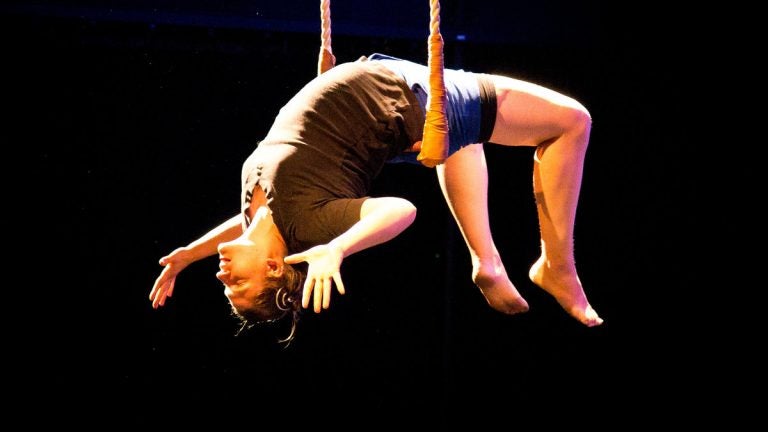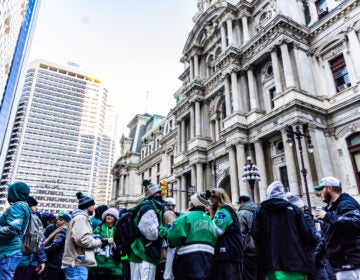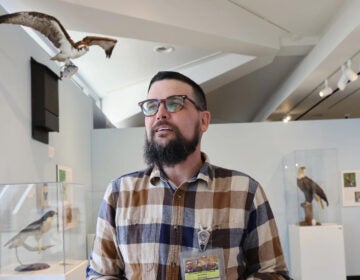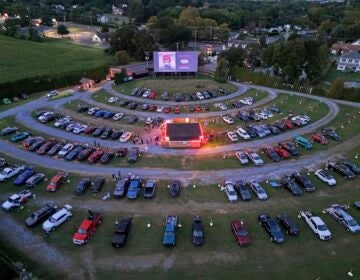What does ‘Fringe’ mean, anyway?

Lauren Rile Smith in Tangle Movement Arts' 'Surface Tension
A man comes at you in an Old City alley and takes you by the hand as other folks dance toward you, then with you. A car in a multi-level University City parking lot swiftly climbs a ramp and as you watch from the back seat, a group of performers appear and one dances on the hood. On a Center City street, you look up as a woman in a wedding dress screams at her groom at the edge of a rooftop.
Fringe-y enough for you?
At many early Philly Fringe Festivals, no one posed that question. Anything new, anything as unusual as the shows above – that’s what lots of people came for. It didn’t matter if it was surprisingly great or stunningly awful. It was the sort of happening you wouldn’t find at the Pennsylvania Ballet or the Walnut. That made it good enough to be Fringe.
Funny thing, though: In 19 years of Fringe Festivals – the 20th edition begins officially Friday with some shows running tonight – we’ve seen so much weird stuff that the cutting edge now may seem a little frayed. Just what happened? And more to the point, what does “Fringe” mean, anyway?
The past shows I’ve cited had a common thread: None of them was done inside a theater. Nowadays, non-traditional settings are less necessary to make a show appealingly unusual, although you’ll still find a dozen or so performances this year in parks, bars and restaurants. And several promising shows curated by the FringeArts, the festival operator, will unfold at non-traditional sites: inside a boxing ring at the Art Museum; “portrait of myself as my father,” nora chipaumire’s dance (in a Fringe move, she doesn’t use caps) at the Navy Yard; Romeo Castellucci’s “Julius Caesar. Spared Parts,” which uses an actor without vocal chords and another with vocal chords displayed on a screen; Pier 9 on the Delaware River, for Ann Hamilton’s immense fabric installation called “Habitus”; the large court at the Barnes Foundation for Jace Clayton’s concert “Room 21”; and the Armory at Drexel for Boris Charmatz’s dance “Levée des conflits.”
Even so, most of the FringeArts-curated are in traditional theater spaces, including FringeArts’ own theater at Race Street and Columbus Avenue, in the shadow of the Ben Franklin Bridge. Nowadays, being fringe-y has more to do with concept and breaking performance barriers than it does with staging your show in a remote meadow of Fairmount Park.
“For us – and I think this is true for the festival as a whole – what defines a lot of these works is that they’re pushing their form, whether it’s dance or theater or something in between,” says Sarah Bishop-Stone, the program director who’s helped to bring work to the festival and to the FringeArts building throughout the year.
“In general, the Fringe movement around the world has its own identity,” she says. “It’s characterized by self-produced artists who come and put up a show and keep most of the income from it. It has a reputation of being scrappier and maybe chaotic. We’ve always had actors working for larger theater companies, but we’re seeing a lot more of them making their own work and doing it wherever it’s good for them.”
I suspect that some people who ask why no one is killing a lobster at each performance, or roaming into four different buildings to solve a mystery, or going to someone’s house to witness a reading done from a bathtub (all past Fringe shows) are a little jaded. And some are carefree enough not to have noticed that a lot of the fringiest material they’ve seen is far from the best. For some people, gimmicks are everything and at times, the form is more important than the content (I admit to being among them at times). And for some people, if it’s done in a darkened room where you sit down and watch, it’s not really outré enough to be fringe art.
But the question of whether a piece is fringe-y enough also seriously addresses why people go to a Fringe Festival. A lot of people go for the risk, hoping that a piece is so phenomenally striking, they’ll never forget it. A lot of people go for the newness – although FringeArts is busy now year-round, a 16-day festival with more than 150 of shows is like a smorgasbord with 150 possible new tastes. And I’m sure people go because watching as artists try to break boundaries is, on its face, worthwhile.
I’m convinced that over the years, as Fringe festivals become more commonplace – Philly’s is now a solid part of the city’s arts scene – the sort of work Fringe artists create become part of the mainstream. We’re more accepting of edginess, and more willing to go Out There. One proof of this is a show called “The Curious Incident of the Dog in the Night-time,” and if you saw it on Broadway, where it won the Tony Award, you know what I mean. (If you didn’t, catch the national tour at the Academy of Music in March.) The show, taken from the popular book, is staged in a traditional theater. But its design, unlikely direction and unusual concept pulls you out of your traditional comfort. I remember turning at intermission to my buddy and saying “Can you believe it? A Fringe show on Broadway?”
What I meant was two things: The sensibility of fringe work, when it’s moving and finds new ways to communicate, can’t help but inform the mainstream. And, wow, can you believe it? A Fringe show on Broadway?
Not every producer is willing to take such risks, of course, but at a Fringe festival, it’s a given that producers will. “Risk differs vastly,” says Jarrod Markman, who coordinates the huge free-for-all of productions that join the festival (as opposed to the 14 shows and one exhibition that FringeArts itself curates). “On one end of the spectrum we have shows with artists coming together for the first time – just that is a big risk, and a financial risk. Other artists are taking risks in their own aesthetics.
But what about the risk for audiences? “A lot of these shows are new – or they’re experimental – and you’re not sure what to expect from that,” Markman says. “It could be a total flop. Or it could be the best show they’ve seen, in a basement and with no props.” That risk is what makes a Fringe-y experience, he says. “Throwing yourself out there – an audience member or an artist – that’s Fringe.”
No matter what Fringe elements a show has or hasn’t, the very fact of the Philly Fringe Festival creates a mindset for ticket-buyers. “There’s a mood,” says Jennifer Childs, the producing artistic director of 1812 Productions, who’s been in edgy Fringe shows and put on more tradition ones as part of the festival. “During Fringe time, audiences seem to be a little bit more open to seeing different things.” Some of her Fringe shows have been presented in another run later in the year, as part of the company’s season. What she’s found: “Audiences are more eager to see something different during the Fringe Festival. It’s the beginning of the season, there’s a buzz happening.”
The city’s most established expert on what makes a show a Fringe show is Nick Stuccio, a co-founder of the festival and the longtime head of it and of FringeArts. A lot of young artists, he says, jump into a Fringe because they got their training in script-based drama or traditional dance – a conventional education. “And when it comes to doing a show at the Fringe, this is an opportunity to try something new and different. Audiences are coming to the Fringe for that reason. They’re generally ready. They know this is going to be unconventional work – and how great is that?”
The Fringe Festival, Stuccio says, has created the platform for that purpose. “As curators, we’re looking for an artist who has discovered something new in the art system that we live in – that’s really a provocative and powerful thing.”
As for fringiness – however you define it — “there’s a big frontier,” he says. “I don’t think we’ve seen and done it all. Please tell me that’s not the case. There are centuries more in the field of art-making we haven’t even imagined yet.”
—
The Philly Fringe Festival runs from Sept. 9 through Sept. 24. For more information: www.fringearts.com.
WHYY is your source for fact-based, in-depth journalism and information. As a nonprofit organization, we rely on financial support from readers like you. Please give today.




